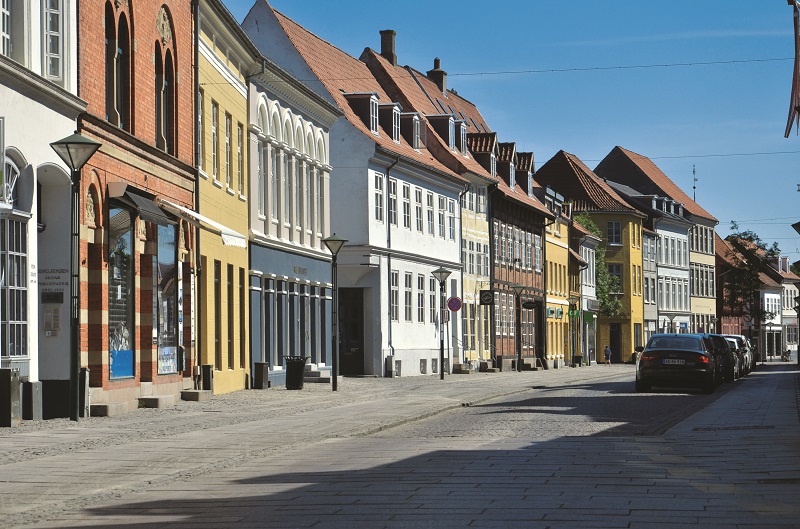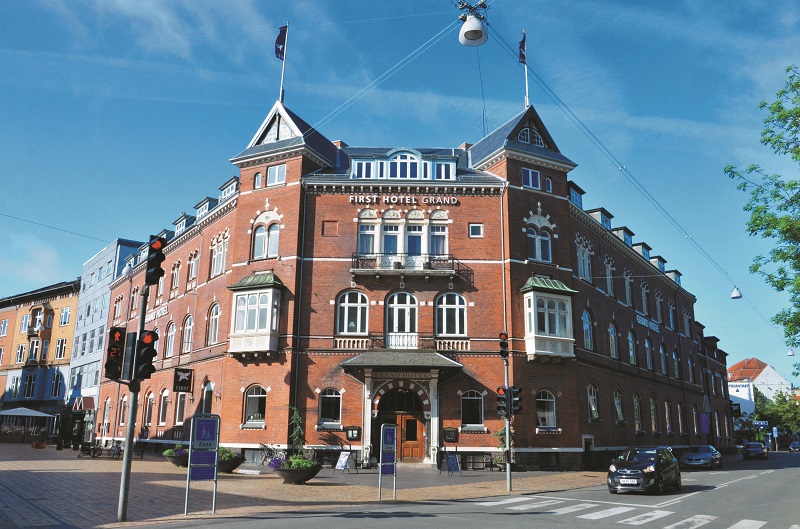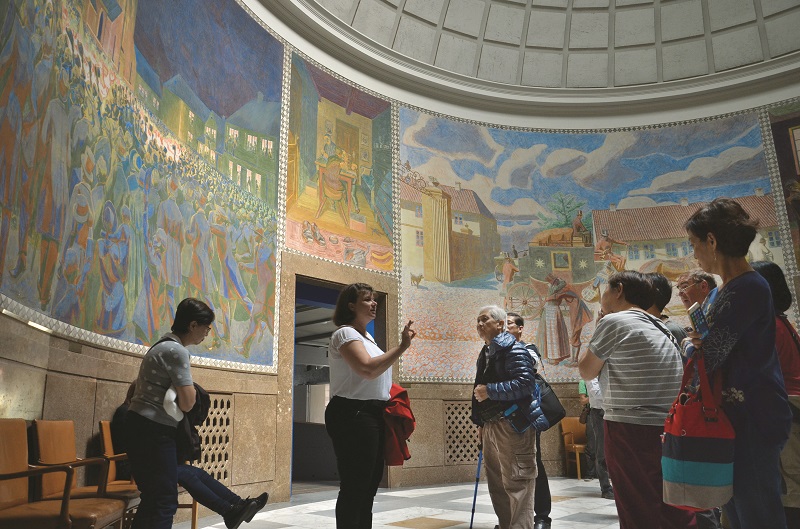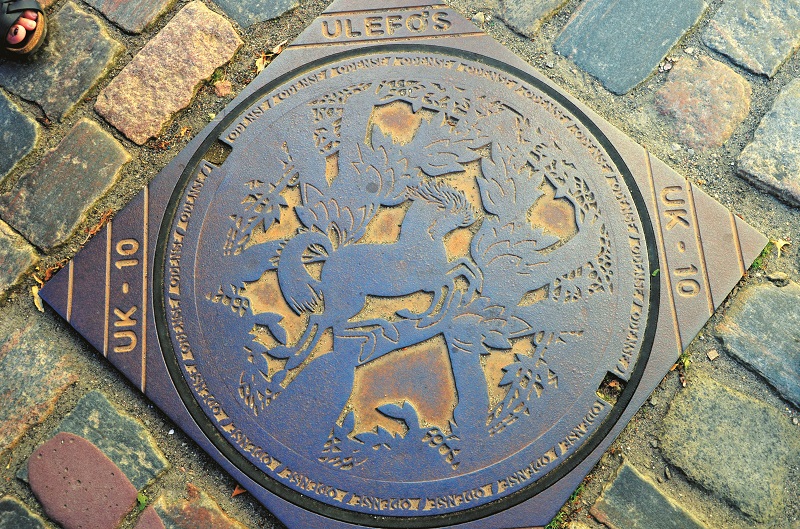
Cathedral of Saint Canute and Statue of Hans C Andersen
Once upon a time, there was a god who traded one of his eyes for wisdom. He had two ravens perched on either shoulder, which would survey his kingdom and bring him news of what was going on, and a magical steed with eight legs that could convey him across the heavens at the speed of lightning. He also had two sons, one of whom was good, and the other, a troublemaker. Their names were Thor and Loki. The god’s name was Odin.
Odin was so revered that a town, Odin’s place, came to be named after him. That is how the city of Odense came by its name.
Odin was a Norse god at a time when Vikings were the scourge of Europe. They were traders but also fearsome pillagers and barbarians. Marvellous sailors, they sailed the seas and oceans in their sleek, technologically superior craft, bringing terror wherever they went. Strong of limb and of an aggressive, fearless disposition, they nonetheless had an appreciation of the finer things in life, bringing back finely-crafted jewellery and slaves as part of their war booty.
Christianity came at the beginning of the millennium, overtaking the mythology of the Norse gods, but the name stuck. Odense is one of the largest cities in Denmark although it has a population of only around 200,000. It is one of the oldest cities in the country, and the largest on the island of Fyn (pronounced “Funnen”).

As the old gods faded and Christianity took hold, a new order arose. The King of Denmark, Canute IV, an avowed Christian, was killed in Odense during a rebel uprising in 1086. Miracles were reported after his death, and he was canonised by the Roman Catholic Church as Saint Canute shortly thereafter.
His ashes are kept in the 15th century cathedral that bears his name in the old city square. He is also depicted in the city’s coat of arms above the doorway of the 19th-century Rathaus, or City Hall building, which is next to the cathedral. There is a small hole in one of his legs on the coat of arms, caused by a bullet. When the Germans overran Denmark in the Second World War, they ran into some resistance from the local police and shots were fired in the city square, one of which hit King Canute’s leg.
The city centre is a pedestrian-only area with red brick buildings and cobblestone streets. Cafés, restaurants, shops and night entertainment outlets are juxtaposed with historical buildings such as the centuries-old Franciscan Greyfriars monastery and the classic First Hotel Grand, which was the first hotel in Odense and one of the first in Denmark. Established in 1897, and still in operation today, the hotel has an elegant dining hall where guests can enjoy their meals in 19th-century splendour.

Walking around the city centre, visitors will notice a trail of large footsteps, size 47, to be precise. These are the imagined footsteps of the city’s most famous son, a multitalented, much-travelled man who wrote novels, poetry, plays and travelogues, and produced elaborate paper cuttings, but he is best known around the world for his children’s fables, which have endured long after his death. His name was Hans Christian Andersen.
Generations of children all over the world have grown up with the stories of Andersen, which have been translated into over 140 languages. The Little Mermaid, The Emperor’s New Clothes, Thumbelina,The Brave Tin Soldier, The Snow Queen, The Little Match Girl, The Princess And The Pea and dozens of others have been favourite bedside reading for generations of children, and have been made into cartoons and movies.
To retrace Andersen’s footsteps is to catch a glimpse into the society of the time. He was born in 1805, the only child of an illiterate washerwoman and a shoemaker, in a one-room house that was bedroom, kitchen, working area and living area all rolled into one. The house is now part of the Hans Christian Andersen Museum.
Today, it is a pretty area with old houses painted in bright colours, but back then, it was a poor neighbourhood not far from the river — the poorer a household, the nearer it was to the river, while the better off lived further away on higher ground. The situation is reversed today, with riverfront property commanding premium prices.
To visit the museum is to understand what a wretched existence it was for the poor in those days. The door frames were small and the ceilings low as people were of smaller build then. Beds were short as it was the custom to sleep in a sitting position rather than lying down.
Andersen was unusually tall, awkward in appearance and was highly strung. He had a miserable childhood, attending a school for the poor where he was mercilessly bullied by the headmaster. There is a plaque outside the old school building with a quote from Andersen. The building is decorated with Odense rose oak embellishments only wealthy families could afford.

The Hans Christian Andersen Museum is a complex with sections dedicated to the man, his stories and his life. Artefacts from his life fill in the man behind the stories. Many of his stories carry an autobiographical narrative, for he was a lonely man who never belonged anywhere and longed for love. His father died when he was young, and his mother became an alcoholic and died in a home for the poor before he gained fame and a measure of wealth.
He never married and had no children. His feelings for a girl early in his life were unrequited. When he died, a leather pouch was found on him, with a letter from his early love, its contents unknown, as they were wisely destroyed to respect his privacy.
Many of his stories are sad, with the theme of not belonging — The Ugly Duckling, The Steadfast Tin Soldier, The Little Match Stick Girl, and so on. Later in life, he developed a great passion for a beautiful Swedish singer who didn’t feel the same way about him. He wrote The Nightingale in her honour, and she became popularly known as the Swedish Nightingale.
When she rejected him, it is said that he wrote The Snow Queen, who had a heart of ice.
There are interesting insights into his life. He had a fear of being buried alive, and of overstaying his welcome when visiting Charles Dickens in England. He was plagued by toothaches. He had a pathological fear of fire, thus his refusal to stay on any floor higher than the second floor. He carried an escape rope, which he tied to the window of the room he was staying in for quick evacuation if needed. He also possessed an astonishing talent for producing delicate paper cuttings with a pair of scissors.

In spite of his nervous disposition, he was widely travelled, spending several years abroad in various countries, although he lived most of his life in Odense. He was vain, could be difficult, and sought the society of others. He ultimately died of liver cancer in 1875, in the care of a friendly family.
The story of Andersen casts a nuanced perspective when walking the cobbled streets of Odense. Although it retains much of the trappings of that early period, modern-day Odense is neat and colourful, befitting a setting for one of his fairy tales, unlike the grimy, filthy city it was then, when trash and sewage clogged the streets, hygiene was so poor that people constantly suffered from illness and life expectancy was short.
Hans Christian Andersen is rightly the most famous son of Odense, with many references to him in statues, cafés, hotels, shops, festivals and tourist memorabilia, but Odense hasn’t forgotten its origins. If you look carefully at the manhole covers in the old city, they are decorated with metal work, some of which commemorate Andersen, and others depicting an eight-legged horse, the image of two ravens, or Odin himself, in the branches of a tree.
This article first appeared on July 30, 2018 in The Edge Malaysia.


